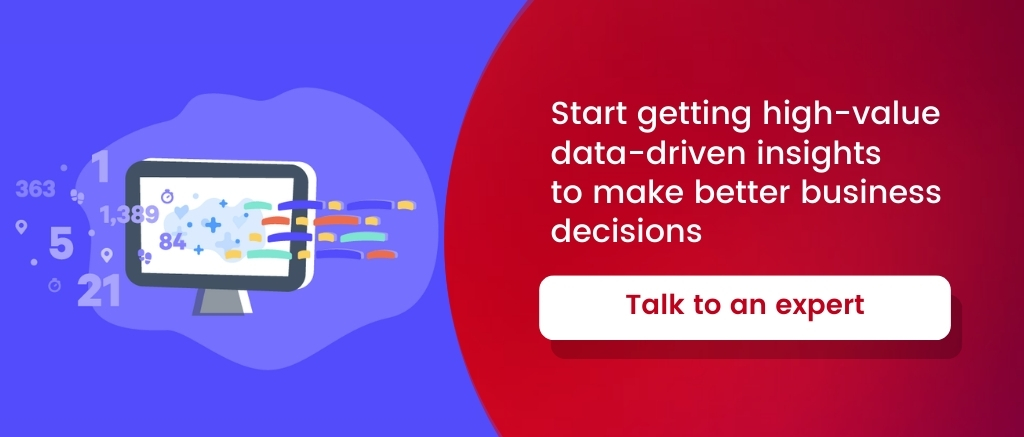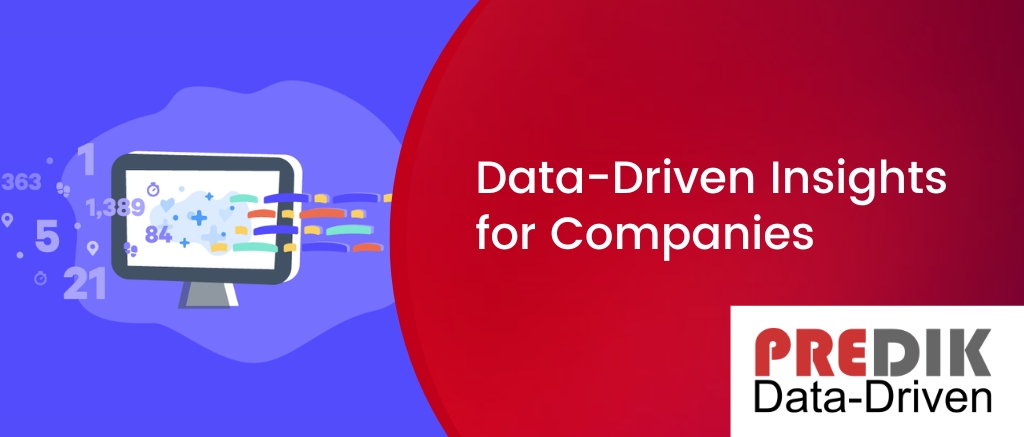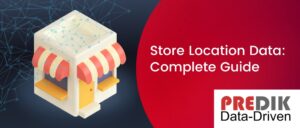Data-driven insights are valuable information businesses can obtain by analyzing the raw data they collect from internal, external, and alternative sources. These insights provide a clear, objective perspective to guide strategic decision-making.
“It is the process of using data to inform your decision-making process and validate a course of action before committing to it.”
Harvard Business School
In this article we will cover the following topics:
Why should organizations focus on getting high-value data-driven insights in 2024?
A few decades ago, it was okay for decision-makers to rely on intuition, internal know-how, or a hunch to make strategic decisions.
However, a solid data approach has become the backbone of growing organizations in today’s competitive business landscape. Data-driven insights provide a broader strategic vision for customers, competitors, and the overall market. They have also become essential for improving complex business strategies, enhancing operations, and embracing digital transformation.
| Feature | Data-Driven Insights | Traditional Insights |
|---|---|---|
| Source | Data collected from different sources (Internal, external and alternative). | Intuition, experience, general market trends |
| Process | Requires data collection, integration, and analysis | Relies on subjective know-how and interpretation |
| Outcome | Objective, actionable information with quantifiable evidence | Subjective understanding, potentially biased by experience |
| Decision-Making | Minimizes risk of errors, leads to evidence-based strategies | Prone to errors due to lack of concrete data |
| Strengths | Provides clear and unbiased perspective | Leverages experience and industry knowledge |
| Weaknesses | Requires investment in data collection and analysis | Prone to bias and limited by individual experience |
| Example | Retail store brand offers personalized messaging based on user’s foot traffic patterns. | Marketing team relies on past data to launch a new product campaign |
For example, Hubspot’s research found that 36% of marketers consider data valuable when reaching target audiences more effectively. On the other hand, Accenture study found that technology leaders are generating revenues at double the pace of technology laggards.
“By leveraging intelligent insights and actions, companies can improve and optimize processes to increase operational excellence, ultimately improving the customer experience.”
Forbes
Five reasons for organizations to use data-driven insights
Better business decisions and strategies
More and better data insights will give you the confidence to commit fully to a particular vision or strategy without being overly concerned that the wrong decision has been made.
However, it’s important to remember that data collection or interpretation flaws can lead to inaccurate decisions despite the data showing a particular pattern or suggesting a certain outcome. This is why it’s critical to regularly measure and monitor every business decision’s impact.
Lower risk and less costly mistake
Studies have found that one of the top initiatives of growing companies is developing innovative solutions based on data-driven intelligence to decrease expenses and improve operational efficiency. Of those, 49% of organizations reported achieving results beyond their expectations (including industry leaders like Disney, GE, American Express, Capital One, Ford Motors, JP Morgan, and MetLife).
“36% of marketers say one of the top reasons they leverage data is to justify their spend.”
Hubspot
It is important to clarify that a data-driven approach is not solely used for cost-cutting purposes. It is also used for “offensive” efforts to change and evolve business operations and increase ROI performance. Once the initial cost-saving measures have been achieved, organizations tend to shift their focus towards innovative ways to utilize data.
We recommend you reading: Is Your Company Data-Driven? (Let’s Find Out)
Better market research
Are you familiar with the concept of “Data-Driven Marketing”? Data-driven marketing involves collecting and using in-depth data insights to make informed marketing decisions, develop more effective marketing strategies, create personalized customer experiences, and better allocate resources.
This data usually turns around consumer demographics, consuming habits, and behaviors, allowing marketers to effectively reach the perfect audience at the right location and time.
More precise forecasting
Using a data-driven approach, companies can gain valuable insights into future outcomes and results. For example, by collecting and analyzing different data types, businesses can predict their market share in the coming years, determine which of their current points of sale (POS) will be the most profitable, or even estimate the potential sales of a new product line in a specific market.

Competitive advantage
Multiple studies have confirmed that companies that rely on data-driven insights tend to outperform their competitors. For instance, McKinsey’s research has found that such organizations have a 23% higher probability of acquiring new customers and are 19 times more likely to achieve better profitability than other players in the market.
Also, BARC found that data analytics enthusiasts increased profit by 8%, and 69% of companies considered “better strategic decisions” one of the main benefits of a data-driven approach. IBM found that six out of ten retailers report a perceived competitive advantage after using data analytics more consistently.
How Baubleblar uses data-driven insights?

Baublebar is a jewelry brand that has been in the fashion market for over ten years. They use analytics as a key strategy to stay relevant and top-of-mind among their customers. They gain valuable insights into current fashion trends and popular tastes by constantly tracking different customer characteristics, such as demographics and interests.
For example, the brand compares its internal data with current social media trends and other information sources to identify patterns and make informed decisions about its next move.
How can you start uncovering data-driven insights for your organization?
Having the right process will be the difference between getting impactful insights to make better decisions and getting wrong information that leads to incorrect conclusions and costly mistakes.
Start with your goals
First, identify your business objectives and the insights you want to get from data. Are you looking to boost brand awareness, grow profits, or explore new markets? Understanding your goals will guide you in choosing the right data to collect and analyze, ultimately uncovering relevant insights for real impact.
It’s important to start with your goals regarding data analysis. Begin by identifying your business objectives and the insights you want to gain from data.
Are you looking to improve brand awareness, increase profit, or explore new markets? Knowing your goals will help you choose the appropriate data to collect and analyze.
Continue by integrating your data
As mentioned earlier, various data sources are available, from internal sales reports to user foot traffic. That is why you must consolidate all your information into a single source to analyze it effectively.
If your organization lacks experience dealing with vast and diverse data volumes, we suggest you partner with a specialized data analytics company (such as PREDIK-Data Driven).
Even if you already have an in-house data team, it is always a good practice to have an external data consultancy team to prevent biases and incorrect use of new data.
Analyze your data
After completing your data integration, it’s time to analyze it and generate actionable insights. Your team must be able to identify patterns in data, look for correlations, and try to understand why these patterns exist.
For this last step, visualizing data through charts and graphs will be crucial for understanding your data. Data visualization helps identify trends and make conclusions faster than raw numbers. Familiarize yourself with popular data visualization techniques and practice creating visuals with any data.
Once you have completed the data integration process, the next step is to analyze it and extract valuable insights. For that, your team must be able to identify patterns and correlations in the data and understand the underlying reasons for these patterns.
To make this last step easier, it is essential to visualize your data through charts and graphs. Data visualization helps to quickly identify trends and draw conclusions that may not be immediately apparent from raw numbers alone.
Remember, learning popular data visualization techniques and practicing creating visuals with any data is always helpful to get the most out of your data.
We recommend you reading: Can you rely on your data? Let’s Talk About Data Reliability
Monitor, test, and fix
To have reliable and high-value data-driven insights, you need constant monitoring, evaluation, testing, and fixing (if needed).
Start small and then escalate
Consider your learning curve. From our experience, the companies that integrate a data-driven approach better are the ones that start with “pilot” projects, make tests, and then escalate their projects little by little.
Final thoughts
It’s important to note that getting data-driven insights doesn’t mean disregarding intuition or opinions. Instead, it’s crucial to interpret data with common sense and experience.
It’s not just the biggest companies that can benefit from a data-driven approach. Although implementing a data-driven approach requires certain investments, the rewards of data-driven decisions are well worth the effort, regardless of your organization’s size.
As your organization becomes more agile and your decisions become more effective, you’ll see immense dividends in the short and long run.



